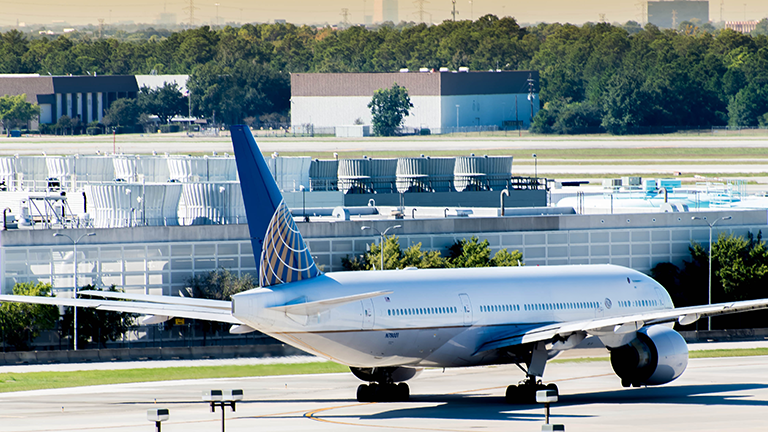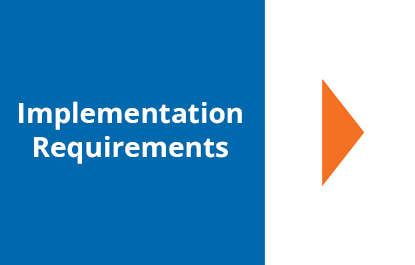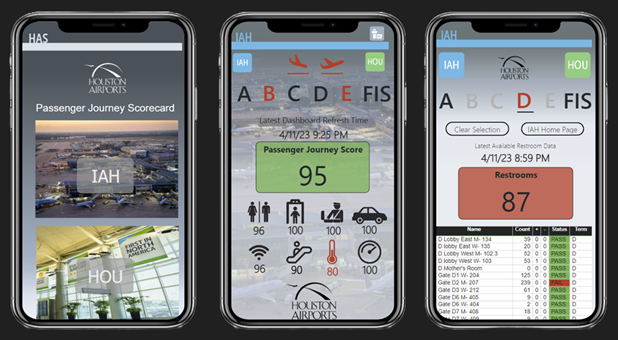Houston Airport System
Customer Journey Scorecard Digital Airport Platform
Houston Airport System (HAS), the City of Houston’s Department of Aviation, manages three airports: George Bush Intercontinental Airport (IAH), William Hobby Airport (HOU), and Ellington Airport/Houston Spaceport (EFD). In 2023, HAS served over 56 million passengers and handled over 549,000 metric tons of air cargo. In addition, the three airports operated by HAS collectively contributed more than $36.4 billion of economic impact to the local economy in 2019 and were directly responsible for more than 190,000 jobs. Houston is the only city in the Western Hemisphere with two Skytrax four-star-rated airports. The HAS data and applications team, which reports to the chief information officer, partnered with operations to develop the Customer Journey Scorecard as a digital platform for reporting analytics on eight key performance areas (KPIs). The scorecard provides employees with feedback to improve operational efficiency.

Airport Demographics
Southwest United States
City of Houston, Texas
3,000 Employees
Data Analytics Capabilities at HAS

- Houston wanted to be the first city in the Western Hemisphere with two airports with a five-star Skytrax rating.
- Airport operations management is traditionally very hierarchical and slow to implement change.
- Leadership wanted creative solutions for tracking the foundational needs of passengers.
- HAS is seeking to increase employee engagement and provide line-of-sight feedback on the customer journey.

- HAS is collecting data on customer feedback about current airport conditions and the passenger experience.
- Terminal managers were deployed to oversee operations (e.g., maintenance, customer service) in each terminal.
- The Customer Journey Scorecard was developed as a digital platform for reporting data on eight KPIs.
- Key areas: roadway traffic, Transportation Security Administration wait times, Customs and Border Patrol, escalators, Wi-Fi connectivity, restroom cleanliness, water pressure, and temperature.
- Scorecard provides employees with valuable feedback on how their activities impact the passenger experience.

Technical Requirements
- Building Amazon Web Services (AWS) data warehouse to ingest and store data from multiple independent sources.
- Installing iPads at restroom exits to collect customer sentiment data on cleanliness in 15-minute intervals.
- An external vendor collected restroom and escalator data, and an open application programming interface was used to pull data into Power BI.
- Digital platform backend was developed using AWS Redshift, Athena, and Lambda functions.
- AWS Redshift connector provides a data gateway between AWS and analytic tools, limiting data pulled into Power BI.
Human Capital Requirements
- Working with third-party vendors for the data collection.
- Hiring a consultant to assist with initial Power BI setup.
- Internal team’s technical expertise and skillset in data analytics/science/engineering; extract, transform, and load (ETL) developer for AWS.

Data and Technology Limitations
- Different sources of data are independent (siloed); third-party vendors may be required for data collection and storage.
- Overcoming technical hurdles—using a data gateway to connect data in the warehouse to analytic tools.
- Using Redshift connector to define the latest data, while limiting the amount of data pulled in Power BI from AWS.
- Looking at potential enhancements, optimizations, and areas of improvement in the data architecture.

- The Customer Journey Scorecard helps improve operational efficiency and the passenger experience.
- The scorecard has a Houston Airports landing page, with passenger scores aggregated from data collected in near real time.
- Internal teams can obtain near real-time data on the passenger experience and insights on customer service.
- Employees receive feedback on performance to increase their engagement with the customer experience.
- Terminal managers can identify steps to improve operations by mitigating issues that affect passengers.
Change Management Strategies
- HAS implemented a “terminal management” policy that assigned a designated manager to oversee operations in each terminal (e.g., maintenance, customer experience).
- The scorecard idea was conceived 10 years ago and matured over time as the data and technology became available to implement the application as a digital analytics platform.
- Buy-in from leadership and internal stakeholders was essential for integrating the needs of different teams. The chief technology officer was very supportive of the project.
Greatest Challenges & Lessons Learned
Challenges
- Tracking and integrating different streams of data and corralling the data to meet the needs of users.
- Finding the right balance between idea, vision of how to use data in practical terms, and implementation.
Lessons
- The management structure was adjusted to focus on operations, logistics, and maintenance in each terminal.
- Starting with a well-defined business problem and using data to improve efficiency were key to success.
- Multiple meetings with senior airport staff were held each week to work out details of the passenger journey score.
Impact to Organization
HAS developed the Customer Journey Scorecard Data as a digital analytics platform for reporting KPIs across eight operational areas. The project goal is to improve operational efficiency with data and meet the needs of different internal teams. The data and analytics team pulled together different streams of data and developed a cloud-based solution with dashboards implemented in Power BI. The scorecard provides feedback to employees about performance to increase engagement with the customer experience. Terminal managers identified steps to improve the passenger journey.
Data Visualizations

Passenger Journey Scorecard: Digital Airport Platform. The Passenger Journey Scorecard metrics represent aggregated scores from passenger feedback in near real time for estimating the customer experience at different operational areas of the airport terminal.
Image credit: HAS Analytics and IT